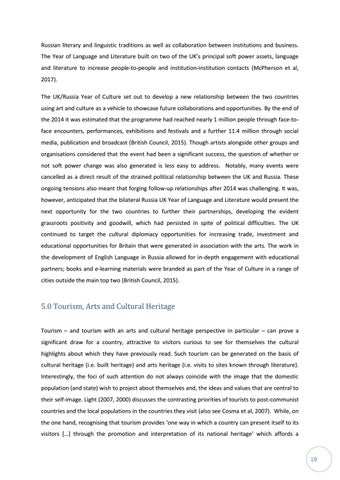Russian literary and linguistic traditions as well as collaboration between institutions and business. The Year of Language and Literature built on two of the UK’s principal soft power assets, language and literature to increase people-to-people and institution-institution contacts (McPherson et al, 2017). The UK/Russia Year of Culture set out to develop a new relationship between the two countries using art and culture as a vehicle to showcase future collaborations and opportunities. By the end of the 2014 it was estimated that the programme had reached nearly 1 million people through face-toface encounters, performances, exhibitions and festivals and a further 11.4 million through social media, publication and broadcast (British Council, 2015). Though artists alongside other groups and organisations considered that the event had been a significant success, the question of whether or not soft power change was also generated is less easy to address. Notably, many events were cancelled as a direct result of the strained political relationship between the UK and Russia. These ongoing tensions also meant that forging follow-up relationships after 2014 was challenging. It was, however, anticipated that the bilateral Russia UK Year of Language and Literature would present the next opportunity for the two countries to further their partnerships, developing the evident grassroots positivity and goodwill, which had persisted in spite of political difficulties. The UK continued to target the cultural diplomacy opportunities for increasing trade, investment and educational opportunities for Britain that were generated in association with the arts. The work in the development of English Language in Russia allowed for in-depth engagement with educational partners; books and e-learning materials were branded as part of the Year of Culture in a range of cities outside the main top two (British Council, 2015).
5.0 Tourism, Arts and Cultural Heritage Tourism – and tourism with an arts and cultural heritage perspective in particular – can prove a significant draw for a country, attractive to visitors curious to see for themselves the cultural highlights about which they have previously read. Such tourism can be generated on the basis of cultural heritage (i.e. built heritage) and arts heritage (i.e. visits to sites known through literature). Interestingly, the foci of such attention do not always coincide with the image that the domestic population (and state) wish to project about themselves and, the ideas and values that are central to their self-image. Light (2007, 2000) discusses the contrasting priorities of tourists to post-communist countries and the local populations in the countries they visit (also see Cosma et al, 2007). While, on the one hand, recognising that tourism provides ‘one way in which a country can present itself to its visitors […] through the promotion and interpretation of its national heritage’ which affords a
19

